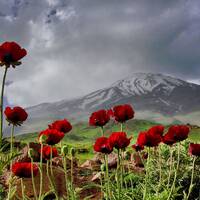
Tiregan
Tiregan is one of the biggest festivals in ancient Iran. Traditionally, it is held on the Tir day (ancient days) of Tir month, equal to the 13th of the month in the Zoroastrian calendar, and equivalent to the 10th of Tir in Shamsi year. Each year the Zoroastrians celebrate this day in honor of Tishtar and perform some special rituals. Tishtar is a star that brings news of rain, and in the Iranian culture and believes it is the brightest star in the sky and it soon will rain once it appears. Tiregan day is the annual celebration of the day that Arash the archer, the legendary hero of Iran, fired his arrow to determine the border of Iran and sacrificed himself for his country. This day is also the celebration of the writers in ancient Iran.
The date of this festival is not the same in all the regions and all the calendars. Tiregan is celebrated on 13th on Tir in the foothills of Rineh city of Larijan in Amol, Mazandaran Province. In Farahan of Markazi Province, at the beginning of the summer, 1st of Tir, they celebrate the ripening of the wheat and its harvest as the first Tiregan. In Gilan, a day named Tirmasinezeh is registered as a spiritual heritage f Iran. In Mazandaran, according to Tapuri calendar (Tabari or Mazandarani), Tiregan is celebrated on the 13th of Aban and is called the Tir Mah Sizdahsho festival, and in Ardehal of Kashan Province, on the 13th of Mehr. In Mehdishahr of Semnan Province, it is called Tir Mo Ee Sizdah on the 22nd of Aban, and in Karizat of Yazd it is celebrated on the first day of Tir and is called Ab, Tir, Mahi. The Armenians of Isfahan celebrate it on the 13th of January, and the Zoroastrians of Kerman they celebrate it on the second week of Tir and call it Tir o Jashn. In some parts of Iran, it is celebrated on the 13th day of Farvardin. In many cities, since this day is not an official holiday, it is celebrated on the closest weekend to it.
This celebration is held near water sources, and people gather there exciting and pour water on each other, and call it Ab Rizan, Ab Pashan, or Sarshuran. It is accompanied by wishing for abundant rains and no draughts. Another part of these celebrations is Fal Kuzeh. On the day before Tiregan, each of the attenders, especially women, fill a green vase called Dulleh, pull a green silk handkerchief on it, and put it with unmarried young girls. Then, they put a small object like a ring or an earring in it. The vase is put under an evergreen tree. On the day of Tiregan, after the Ab Rizan, all the people who had put an object in the vase gather around it, and they sing songs one by one. The young girls put out one of the objects, and it is cleared that the poem relates to the wish of the owner of that object. Dastband-e Tir o Bad is another attractive tradition of this celebration and is accompanied by the singing of some special songs. At the beginning of the festival, after having some sweets, people tie a thread weaved with seven different yarns called Tir o Bad to their wrists. Nine days later they untie the thread and put it in a high location like a rooftop so that the wind would carry their wishes like a messenger. There are other traditions related to Tiregan, and they vary in each region. They include staying up all night, playing games, and local competitions, having sweets and fruits, singing songs and reading poems of Hafiz, Shahnameh, etc.

.jpg)

.jpg)

.jpg)
